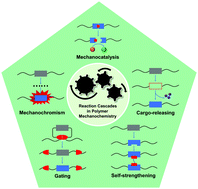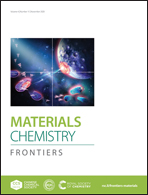Reaction Cascades in Polymer Mechanochemistry
Abstract
This review summarizes the development of polymer mechanochemistry-enabled reaction cascades. According to different functions or purposes, we categorize the reported reaction cascades in polymer mechanochemistry into five parts, including mechanocatalysis, cargo-releasing, self-strengthening, gating, and mechanochromism. Mechanocatalysis refers to the force-induced latent catalyst activation and the following catalysis reaction. All reported mechanocatalysts are organometallic coordinated complexes with activated metallic atoms from ruptured coordinate bonds upon force action. Cargo-releasing represents the small molecules released from the designed mechanophores in polymer chains by mechanical disturbance. Commonly, the generation of cargo involves two steps, production of an unstable intermediate and then spontaneous decomposition into small molecules. Self-strengthening usually involves the crosslinking of polymers or formation of new polymer networks triggered by the force-generated active species, and then the mechanical properties of polymeric materials are reinforced. Gating means regulating the desired chemical reactions by specific stimuli. Mechanophores embedded in polymers can be used to control other stimuli-responsive reactions, for example, mechanochemical ring-opening, photoswitching, or degradable reactions. Cascade-enabled mechanochromism is quite different from one-step mechanochromism and has advantages such as the acquisition of more marvellous functions and avoiding unnecessarily complicated design of mechanophores. Finally, some outlook for reaction cascades in polymer mechanochemistry is provided.

- This article is part of the themed collection: 2020 Materials Chemistry Frontiers Review-type Articles


 Please wait while we load your content...
Please wait while we load your content...